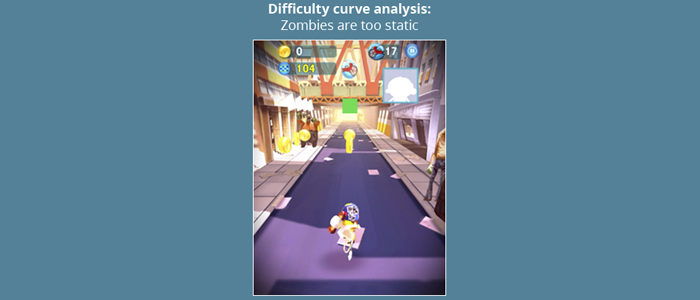· 4 min read
Zombies Don’t Touch Me: Runner Under the Microscope
Yaniv Nizan
Yaniv Nizan is the CEO and Co-Founder of SOOMLA - Monetization Measurement Platform.
Have you seen kids play runner games? They look so immersed, sometimes it seems they could start running themselves. Somehow the fast paced, coming at you in 3d experience gets you sucked into the game very quickly. Zombies don’t touch me (ZDTM) is no different in that aspect, while it variates on the theme with a cool zombie world and awesome electric guitar sounds that harmoniously fit in with the coin collection sound effects.
Analyzing the core gameplay
Users who play ZDTM quickly learn that controlling the monkey boy is very intuitive, as it leverages the control system from other runner games: swiping left, right, up and down. The basic idea is simple: there’s a boy running and whenever a zombie comes at him on his lane he should move, duck or jump to avoid it. In my view, the game wasn’t too much of a challenge to play, and the experience not very diverse. There are two easy ways to fix this:
- Make some of the zombies move towards the user;
- Add challenges to the upper decks and the underground floors.

Game economy analysis
The main monetization source consists of in-app purchases. We already know that this is by far the model with the most potential, especially when combined with an in-game coin system. Not surprisingly, the designer chose to include coins and even extended the model to two currencies.
Let’s take a look at the in-app purchases available in the store:
- Single use items:
- Red bike – protects against one zombie attack
- Upgradable goods:
- Red bike – 5 levels that increase duration
- Coin magnet – 5 levels that increase duration
- Score multiplier – 5 levels: 2x, 3x, …
- Premium Items for cash purchase
- Double coins – $4.99
- Coin pack – allows for buying the ingame items
- Blood pack – used at the end of the session for ‘save me’ cheat
This is a very good start, but there is room for better balancing. Three ways to improve the current experience:
- The amount of coins collected in a session needs to allow users to buy the least expensive item in the store;
- Blood cells (premium currency) need to be available in gameplay as well, but only once every 2-3 sessions (rare item);
- The single use items needs to make the game easier, but for this to be effective the base game mode needs to be harder.
Save me is an effective monetization source
One thing that is common to all runner games is that the character always dies. It may happen very soon, or it may take a while, but the end is always the same. This is why “Save Me” cheats and runners usually come in pairs. ZDTM’s designer was not a stranger to this fact, and added the cheat to the game. The user experience however can be improved. Spontaneous purchases like this one need to go very smoothly, however in this game it doesn’t happen as smoothly as it could.

Character upgrades could add revenue
The adorable monkey boy has the potential of getting users emotionally attached. Moreover, the game’s 3D environment adds to the character’s personality. These two observations lead me to believe that there is a missed opportunity here, and that more revenue can be generated by creating a world of characters and upgrades. Starting off with 5-10 base characters, each with a unique look and allowing users to get invested in upgrading them. When executed correctly, this should lead to increased emotional connection, better long-term retention and additional revenue. Though plenty of the runner games out there offer some character options, the best reference for this, in my opinion, would be Angry Birds Go.
The door to the ingame store
In-app purchase based monetisation relies on making it easy for users to buy. The easier it is for them, the better it is for you. Zombies don’t touch me can improve this aspect in 4 ways:
- Adding a featured item widget that could be presented at the end of a session;
- Including the store button in the pause screen;
- Adding a session end screen with “try again” and “go to store” buttons;
- Making specific missions that send the user to the store.